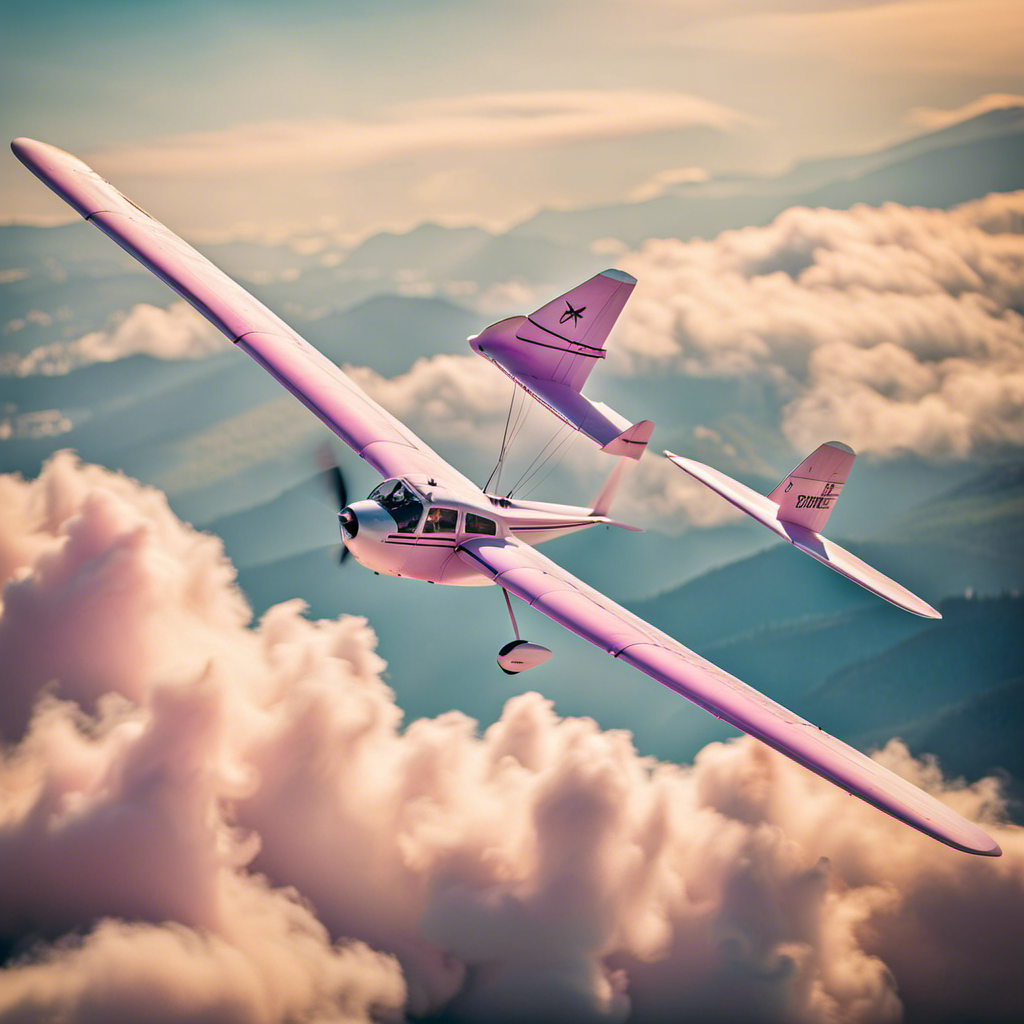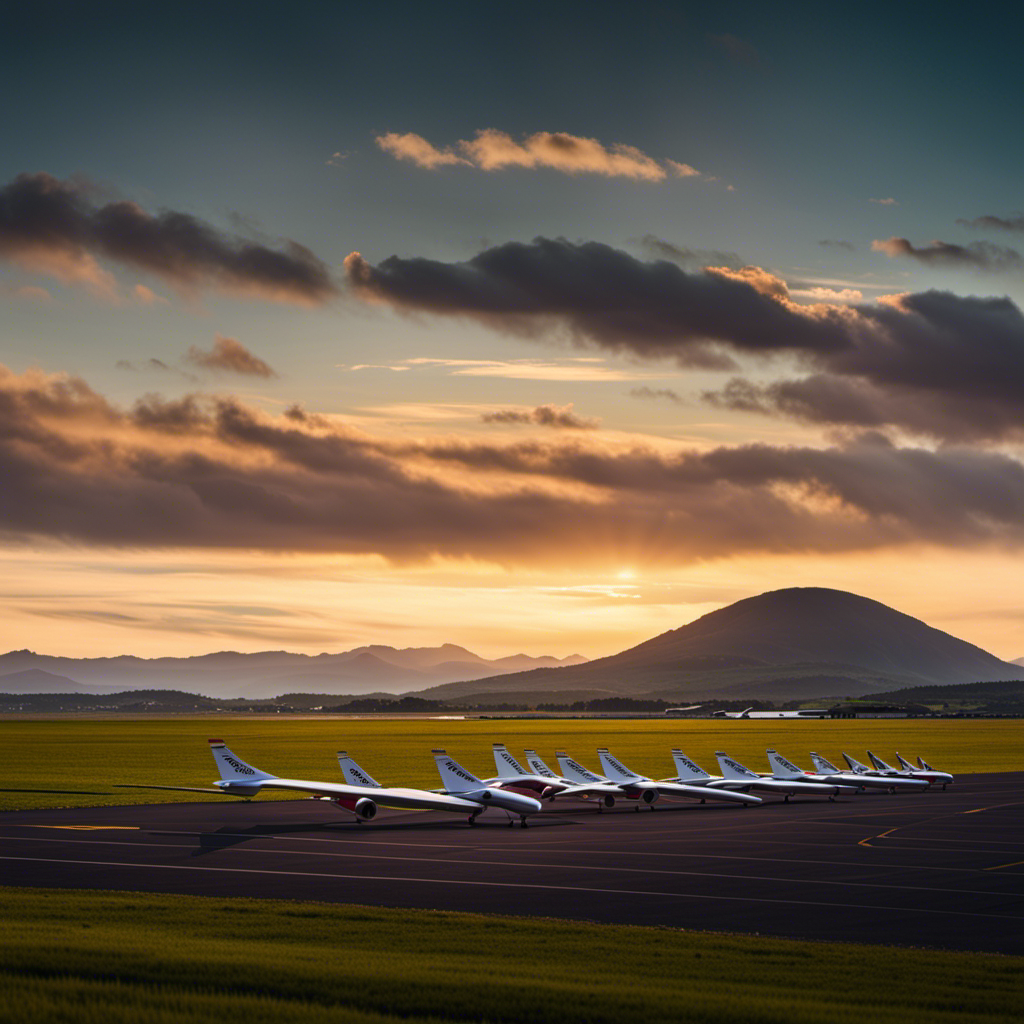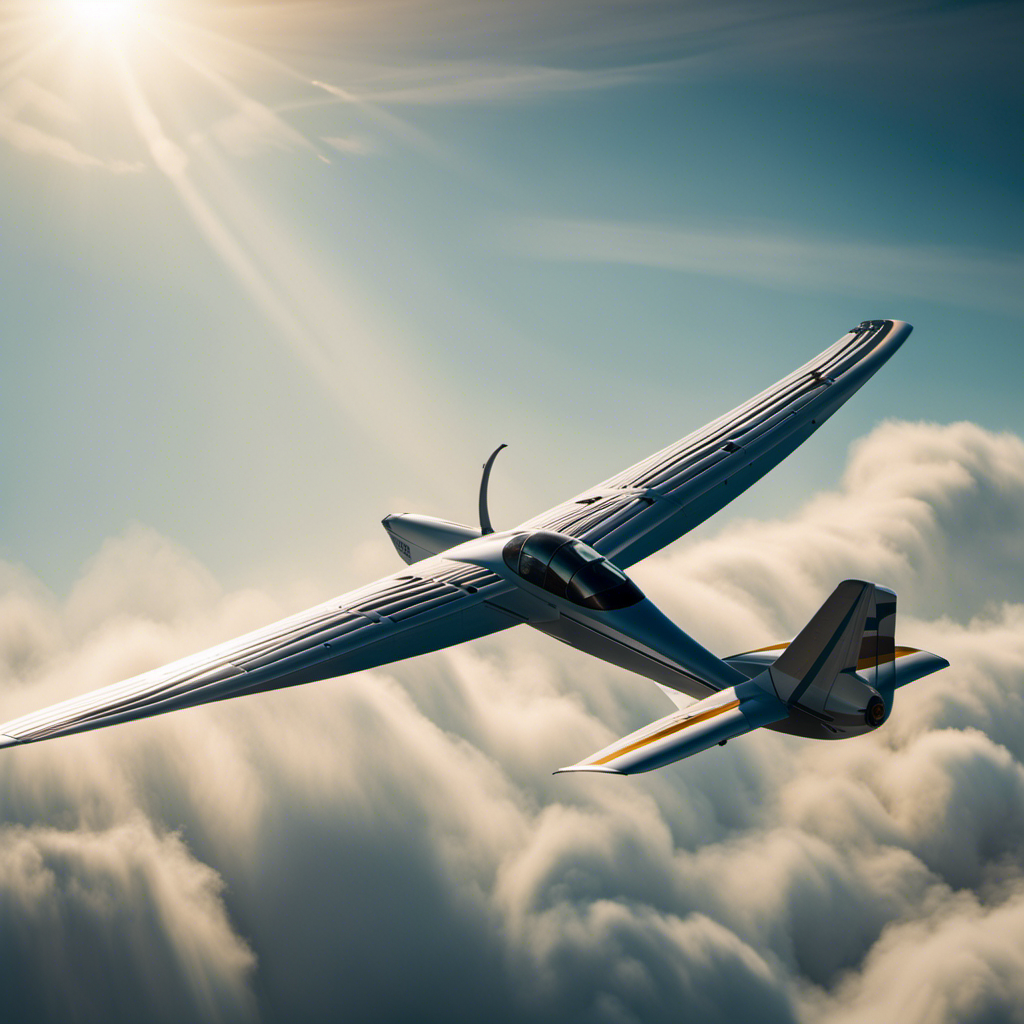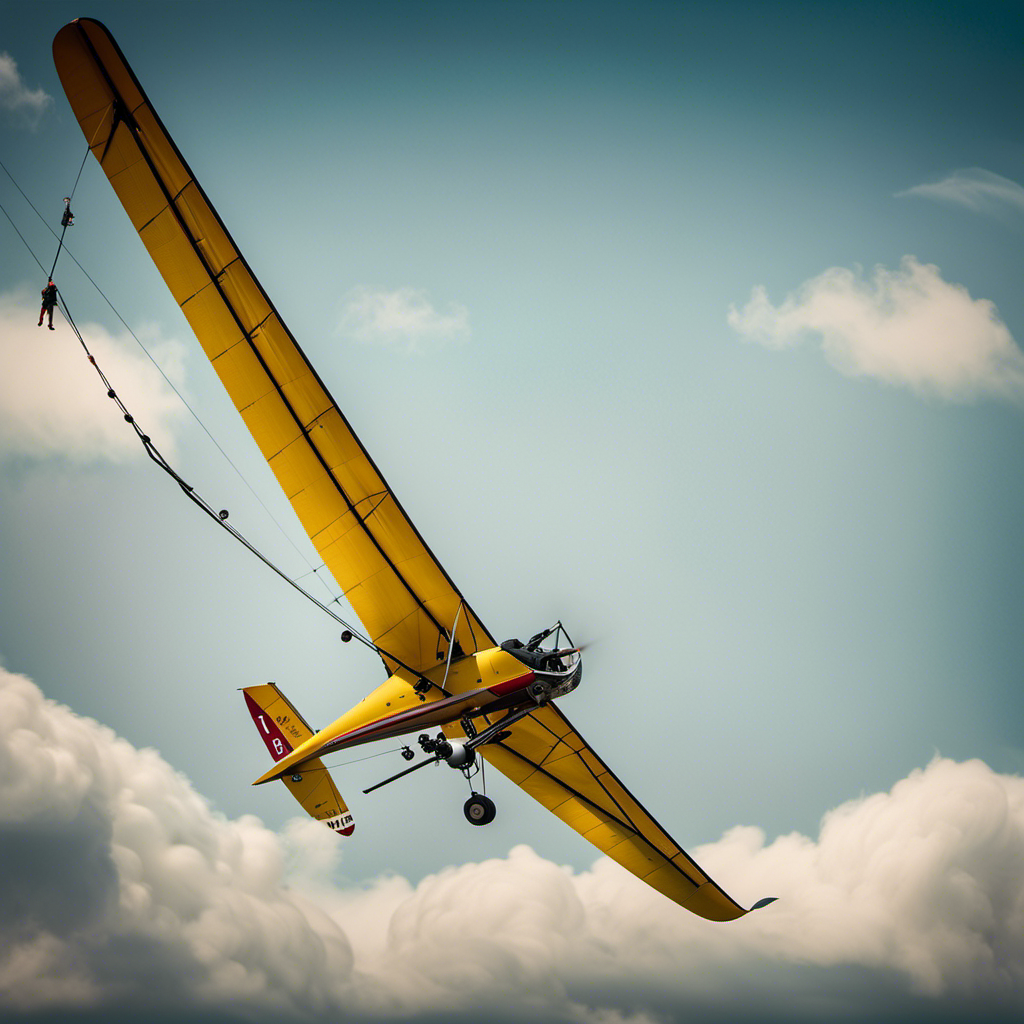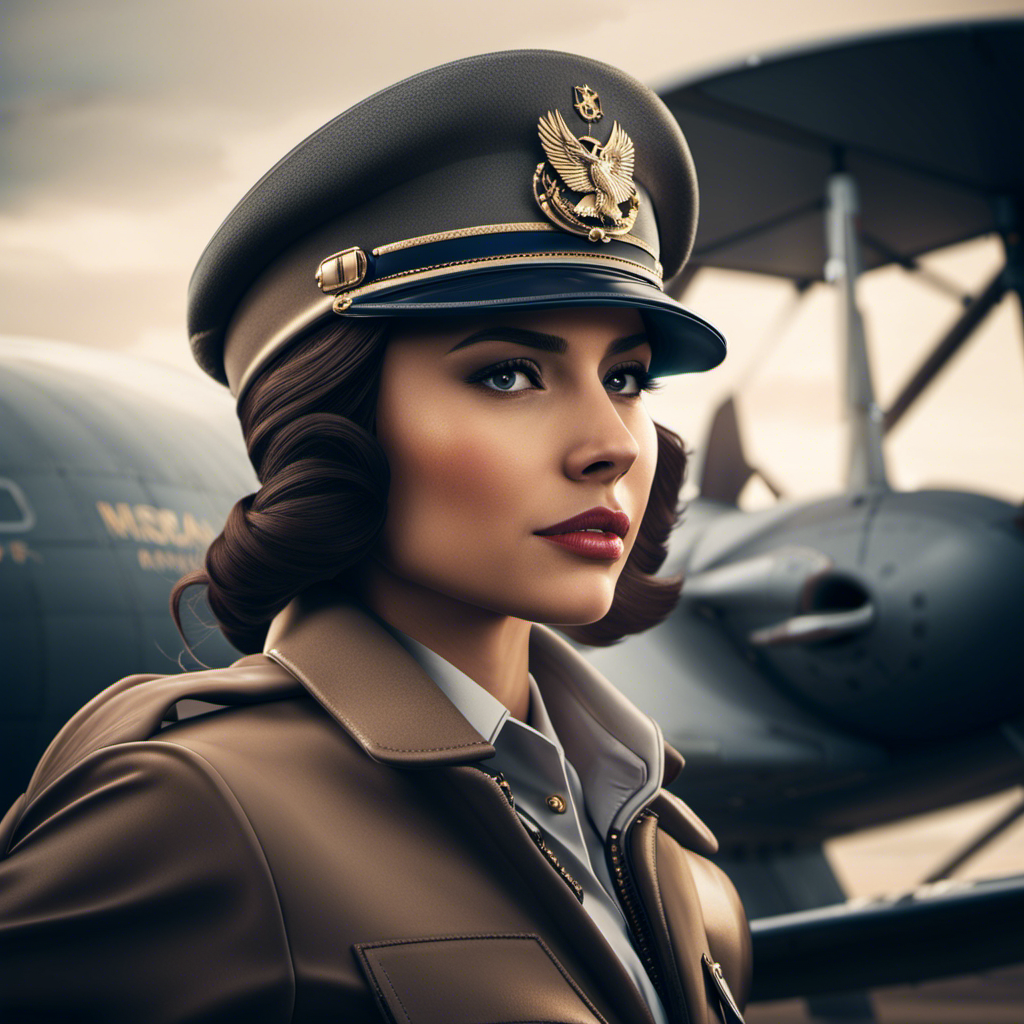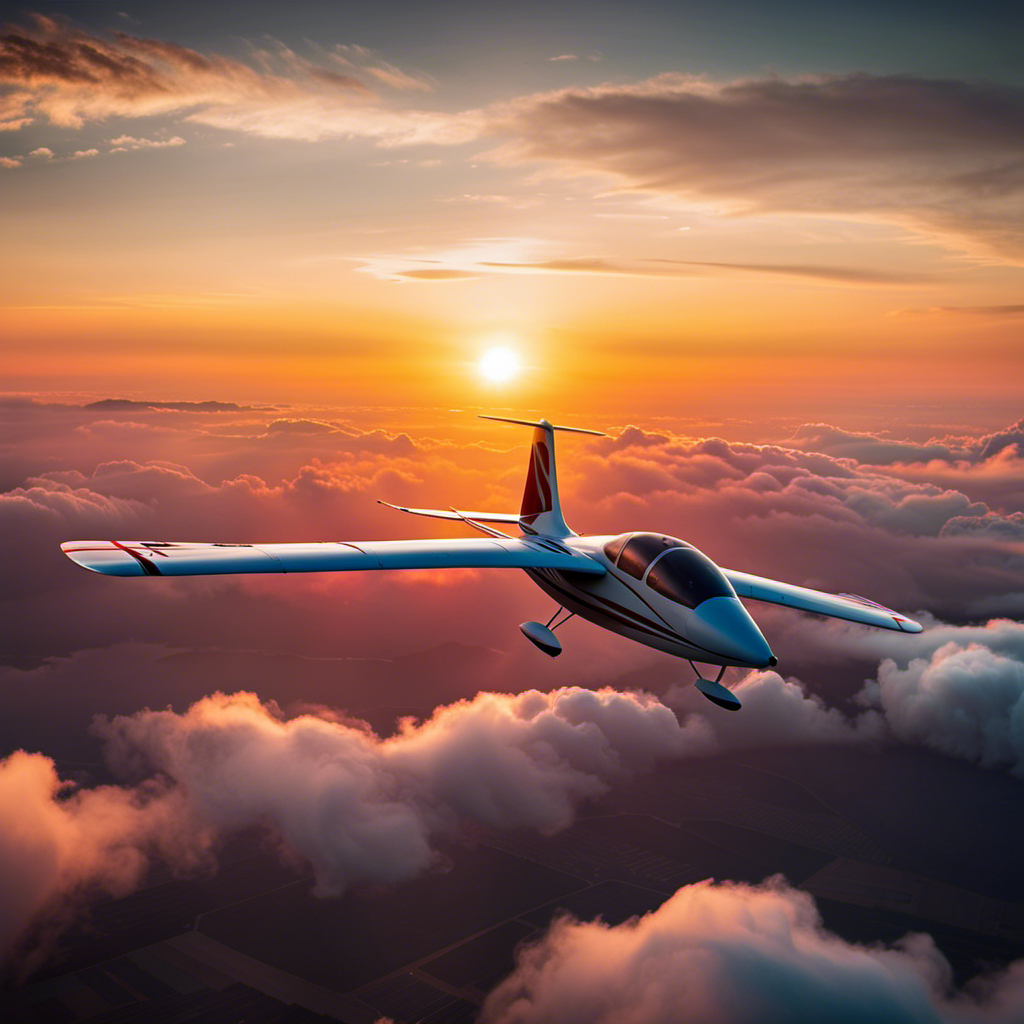As I glide through the heavens, feeling as light and liberated as a bird, the charm of engineless sailplanes completely enthralls me.
In this article, we will explore the rich history, the mechanics behind staying aloft, and the exhilaration of silent flight.
I will also share the skills and techniques that glider pilots master, the unique designs and features of glider planes, and the training required to become a licensed pilot.
Join me on this journey into the world of pure flight.
Key Takeaways
- Glider planes have a rich history dating back to the late 19th century, with Otto Lilienthal accomplishing the first successful glider flight in 1891.
- Engineless flight offers a tranquil and peaceful experience, allowing for a serene connection with nature.
- Gliding allows for a deeper connection with nature, providing experiences such as feeling the wind on your face, hearing the sounds of nature, observing the changing colors of the landscape, and smelling the fresh air and scents of the natural environment.
- Glider pilots must have a strong understanding of aerodynamics, flight controls, navigation, and weather analysis, as well as proficiency in safety procedures and regular checks.
The History of Glider Planes
If you’re interested in the history of glider planes, you’ll be fascinated by their origins and evolution.
Glider planes, also known as sailplanes, have a rich history that dates back to the late 19th century.
The first successful glider flight was accomplished by Otto Lilienthal in 1891. He designed and built a series of gliders, which he used to study and perfect the art of gliding.
Lilienthal’s work laid the foundation for future pioneers like the Wright brothers, who used gliders as a stepping stone towards powered flight.
Over the years, glider planes have undergone significant advancements in design and technology, leading to the development of modern-day gliders capable of soaring for hours at a time.
Understanding the history of glider planes sets the stage for exploring how they stay aloft.
How Glider Planes Stay Aloft
To stay aloft, I rely on the forces of lift and gravity to control my glider aircraft.
Lift is generated by the shape of the wings and the air flowing over them. This upward force counters the pull of gravity, allowing the glider to remain in the air. By adjusting the pitch and angle of attack, I can control the amount of lift and maintain altitude or descend.
Gravity, on the other hand, acts as a constant force pulling the glider downwards. To descend, I simply reduce the lift by decreasing the angle of attack.
This delicate balance between lift and gravity allows me to glide through the air effortlessly, feeling the thrill of silent flight and the freedom of soaring like a bird.
The Thrill of Silent Flight
When it comes to the allure of engineless flight, the tranquility is unmatched. Gliding through the air without the noise and vibration of an engine allows for a serene and peaceful experience.
The unique sensation of soaring, as the wind carries the glider effortlessly through the sky, is a feeling like no other. And in this state of pure flight, connecting with nature becomes even more profound, as you become one with the elements and witness the beauty of the world from a whole new perspective.
The tranquility of engineless flight
Experience the serene tranquility of soaring through the sky in an engineless glider plane. Glider planes, also known as sailplanes, offer a unique opportunity to detach from the noise and commotion of the world below and embrace the peacefulness of the open air.
Picture yourself gliding effortlessly through the clouds, feeling the gentle breeze against your face as you navigate the vast expanse of the sky. The absence of an engine allows for an uninterrupted connection with nature, as the only sound you hear is the whisper of the wind.
It’s a remarkable experience that truly immerses you in the beauty and serenity of flight. As you soar through the heavens, you can’t help but be captivated by the unique sensation of soaring, which will be explored in the next section.
The unique sensation of soaring
As I glide through the sky, the sensation of weightlessness is truly extraordinary. With the engineless glider plane soaring gracefully above the earth, it feels as if I am one with the wind and the clouds.
The absence of engine noise allows me to fully immerse myself in the serene atmosphere, surrounded by the vast expanse of the sky. The sheer beauty of the natural world becomes even more apparent from this perspective, as I witness the changing colors of the landscape and the dance of sunlight on the water below.
It is a humbling experience to witness the power and harmony of nature from such a unique vantage point. In the next section, we will explore the ways in which flying in a glider connects us with nature in the sky.
Connecting with nature in the sky
While soaring through the sky in a glider, you can truly connect with nature and experience the beauty of the world from a unique perspective. It’s an exhilarating feeling to be up there, surrounded by the vastness of the sky and the stunning landscape below.
Here are some of the ways in which gliding allows you to connect with nature:
- Feeling the wind on your face as you glide through the air
- Hearing the sounds of nature, such as birds chirping and leaves rustling
- Seeing the changing colors of the landscape as you soar above it
- Smelling the fresh air and the scents of the natural environment
- Observing wildlife in their natural habitat, from a bird’s eye view
As a glider pilot, these experiences become part of your repertoire of skills and techniques, allowing you to navigate the sky with finesse and precision.
Skills and Techniques for Glider Pilots
As a glider pilot, understanding aerodynamics and flight controls is crucial for safe and efficient flying.
By mastering the principles of lift, drag, and weight distribution, I am able to control the glider’s movements and make precise adjustments during flight.
Additionally, navigation and weather analysis play a vital role in planning my flights and avoiding potential hazards.
By staying informed about weather patterns and understanding how they can impact my flight, I can make informed decisions to ensure a smooth and enjoyable experience.
Lastly, being prepared for emergencies and taking safety precautions is of utmost importance.
I am trained in emergency procedures and regularly conduct safety checks to mitigate any potential risks during my flights.
Aerodynamics and flight controls
Gliders use sophisticated aerodynamics and flight controls to stay in the air without an engine. These elegant aircraft rely on a combination of factors to achieve and maintain flight:
-
Wing design: Gliders have long, slender wings that generate lift by utilizing the Bernoulli principle. The shape and angle of the wings create a pressure difference, enabling the glider to stay airborne.
-
Control surfaces: Gliders are equipped with ailerons, elevators, and rudders to control their movement in the air. By manipulating these surfaces, pilots can adjust the glider’s roll, pitch, and yaw.
-
Ballast system: Gliders often have a ballast system that allows pilots to adjust the aircraft’s weight distribution. This feature enables them to optimize performance in different flight conditions.
-
Spoilers and airbrakes: Gliders utilize spoilers and airbrakes to increase drag and reduce lift. These devices aid in descent, speed control, and precise landings.
Understanding the aerodynamics and mastering the flight controls is crucial for glider pilots to safely maneuver and enjoy the freedom of engineless flight.
Transitioning into navigation and weather analysis, pilots must also consider external factors to plan their flights effectively.
Navigation and weather analysis
To effectively navigate and analyze the weather, I rely on a combination of tools and information. By utilizing these resources, I can make informed decisions while flying my glider plane.
One of the primary tools I use is a weather app or website that provides real-time weather updates and forecasts. This allows me to assess the current and future weather conditions at my location and along my planned route.
Additionally, I rely on a variety of instruments onboard my glider, such as an altimeter, variometer, and compass, to monitor my altitude, climb rate, and direction. These instruments, combined with my understanding of weather patterns and cloud formations, enable me to make intelligent navigation decisions for a safe and enjoyable flight.
By being aware of the weather and utilizing the right tools, I can ensure a smooth and successful flight.
Transitioning to the next section about emergency procedures and safety precautions, it is crucial to always be prepared for unexpected situations while flying.
Emergency procedures and safety precautions
When encountering an emergency situation while flying, you must follow the proper safety procedures in order to ensure your well-being and minimize any potential risks. Here are three important steps to take during an emergency in a glider plane:
-
Maintain calmness and focus: It’s crucial to stay composed and level-headed during an emergency. Panic can cloud your judgment and hinder your ability to make rational decisions.
-
Assess the situation: Take a quick but thorough assessment of the problem at hand. Identify the nature and severity of the emergency, as well as any immediate threats to your safety.
-
Follow emergency protocols: Every glider plane should have specific emergency procedures outlined in its manual. Familiarize yourself with these protocols beforehand, so you can swiftly and efficiently carry them out if needed.
By following these safety measures, you can effectively handle emergencies while flying in a glider plane.
Now, let’s explore the various designs and features that make glider planes unique and captivating.
Glider Plane Designs and Features
When it comes to glider plane designs and features, there are several key points to consider.
First, the wing configurations and materials play a crucial role in the performance and efficiency of the glider. The choice of materials and the design of the wings can greatly impact the glider’s ability to generate lift and maintain stability.
Second, the cockpit layout and instruments are designed to provide the pilot with essential information and controls for safe and effective flying. The placement of instruments and the layout of the cockpit can vary depending on the specific glider model, but the overall goal is to provide the pilot with easy access to necessary information and controls.
Lastly, safety systems and emergency equipment are vital in ensuring the pilot’s safety in case of unforeseen circumstances. Gliders are equipped with various safety features, such as emergency parachutes and emergency locator transmitters, to assist the pilot in case of emergency situations.
Wing configurations and materials
You’ll notice that wing configurations and materials play a crucial role in the performance of engineless glider planes. The design and shape of the wings determine how the glider generates lift and how it handles in the air.
Glider wings are typically long and slender, allowing for efficient gliding through the air. The materials used in the construction of the wings are lightweight yet strong, usually made of composite materials like carbon fiber or fiberglass. These materials ensure that the wings are able to withstand the forces encountered during flight while keeping the weight of the glider to a minimum.
As we move on to the next section about cockpit layout and instruments, it’s important to understand how the wing design and materials contribute to the overall flight experience.
Cockpit layout and instruments
The cockpit of a glider plane is designed with a layout that maximizes efficiency and provides easy access to instruments. The pilot’s seat is positioned in the center, allowing for a balanced weight distribution and optimal visibility. The control stick is located within easy reach, enabling precise maneuvering. The instrument panel is organized in a logical manner, with essential gauges and indicators placed directly in front of the pilot. To further enhance the pilot’s experience, a 3 column and 5 row table is provided below, highlighting the key instruments found in a typical glider cockpit:
| Column 1 | Column 2 | Column 3 |
|---|---|---|
| Altimeter | Airspeed indicator | Variometer |
| Turn coordinator | Compass | Vertical speed |
| G-meter | Flap indicator | Radio |
| GPS | Trim indicator | Oxygen system |
| Engine instruments | Emergency parachute | Navigation lights |
With this well-organized cockpit layout and easy access to instruments, the pilot can focus on flying efficiently and safely. Speaking of safety, let’s now explore the various safety systems and emergency equipment that are crucial for glider pilots.
Safety systems and emergency equipment
As I familiarized myself with the cockpit layout and instruments of the glider plane, my attention turned to the safety systems and emergency equipment. Ensuring the utmost safety while soaring through the skies without an engine is of paramount importance. Here are four crucial safety features and emergency equipment found in glider planes:
-
Parachute Systems: Glider planes are equipped with emergency parachute systems that can be deployed in the event of a catastrophic failure or uncontrollable situation.
-
Emergency Locator Transmitter (ELT): An ELT is installed in glider planes to transmit distress signals in case of an emergency, helping search and rescue teams locate the aircraft.
-
Fire Extinguisher: Glider planes are equipped with fire extinguishers to combat any potential fire hazards that may arise during flight.
-
First Aid Kit: A well-stocked first aid kit is essential to provide immediate medical assistance in case of injuries or emergencies during flight.
Transitioning seamlessly into the subsequent section, let’s explore the vibrant world of glider clubs and communities.
Glider Clubs and Communities
Joining a glider club can provide you with a strong sense of community and a chance to connect with fellow soaring enthusiasts. These clubs are made up of people who share a passion for gliding and offer a supportive environment for pilots of all levels.
Whether you are a beginner or an experienced glider pilot, being part of a club allows you to learn from others, share experiences, and gain valuable insights. Glider clubs often organize social events, competitions, and group flights, fostering a vibrant community spirit. It’s a great opportunity to meet like-minded individuals and build lasting friendships.
Training and Licensing for Glider Pilots
Obtaining a glider pilot license is an exciting and rewarding journey that requires dedication and commitment.
There are various training programs and flight schools available to help aspiring pilots learn the necessary skills and knowledge.
Additionally, continuing education and certifications are crucial for staying current and advancing in the field of glider piloting.
Obtaining a glider pilot license
Getting a glider pilot license is an exciting step towards experiencing the freedom of engineless flight. Aspiring glider pilots must meet certain requirements and undergo training to obtain their license. The table below provides a brief overview of the process:
| Requirement | Description |
|---|---|
| Age | Must be at least 14 years old to fly solo, and 16 years old to obtain a license. |
| Medical Fitness | Must pass a medical examination to ensure physical fitness for flying. |
| Ground School | Complete ground school training covering topics such as aerodynamics and meteorology. |
| Flight Training | Log a minimum number of flight hours and demonstrate proficiency in various maneuvers. |
| Written Exam | Pass a written exam covering theoretical knowledge of glider operations. |
| Practical Exam | Successfully complete a practical exam, demonstrating skills and knowledge required for safe glider flying. |
Once licensed, glider pilots can further enhance their skills and knowledge through advanced training programs and flight schools, allowing them to explore new challenges and adventures in the world of engineless flight.
Training programs and flight schools
When you’re ready to take your glider piloting skills to the next level, there are various training programs and flight schools available to help you improve and expand your knowledge.
These programs offer comprehensive training that covers everything from basic flight maneuvers to advanced cross-country navigation techniques. Flight schools provide both ground instruction and hands-on flying experience, allowing you to learn and practice in a safe and controlled environment. Instructors at these schools are highly experienced and knowledgeable, ensuring that you receive the best education possible.
Additionally, many training programs offer specialized courses, such as aerobatics or mountain flying, allowing you to tailor your training to your specific interests and goals.
Continuing education and certifications
To stay current and advance my skills as a glider pilot, I should consider pursuing continuing education and obtaining certifications. Continuing education allows me to learn new techniques, stay updated on the latest safety protocols, and refine my flying abilities. By participating in courses and workshops, I can enhance my knowledge of meteorology, navigation, and aerodynamics.
Furthermore, obtaining certifications such as the Private Pilot Glider License or the Advanced Glider Pilot Certificate demonstrates my proficiency and dedication to the craft. These credentials not only boost my confidence but also open up opportunities for me to fly in different locations and participate in competitions. As I continue to expand my knowledge and expertise, I can ensure that I am well-prepared to handle any challenges that may arise during my glider flights.
When it comes to glider plane maintenance and care, it is essential to prioritize regular inspections and upkeep.
Glider Plane Maintenance and Care
You’ll need to regularly inspect and clean the wings of your glider plane to ensure optimal performance. Here are three important maintenance tasks to keep in mind:
-
Check for any signs of damage or wear on the wings. Look for cracks, dents, or loose parts that could affect the aerodynamics of the plane. Repair or replace any damaged components promptly.
-
Clean the wings thoroughly to remove dirt, dust, and debris. This not only improves the appearance of your glider but also ensures smooth airflow over the wings, enhancing its performance. Use a mild soap and water solution to gently wash the wings, and avoid using harsh chemicals or abrasive materials.
-
Inspect the control surfaces, such as ailerons and flaps, for proper functionality. Make sure they move freely and smoothly without any obstructions. Lubricate the hinges if necessary to prevent binding.
By regularly inspecting and maintaining your glider plane’s wings, you can ensure its optimal performance and safety in the air.
As we look ahead to the future of engineless flight, advancements in technology and design will continue to shape the world of glider planes.
The Future of Engineless Flight
As we explore the future of engineless flight, it is important to consider the advancements in glider technology that have paved the way for sustainable aviation.
These advancements have not only reduced the environmental impact of flying, but have also opened up new potential applications and innovations in the field.
From improved aerodynamics to innovative materials, glider technology continues to evolve, offering exciting possibilities for the future of aviation.
Advancements in glider technology
Imagine soaring through the sky in a glider plane equipped with the latest advancements in technology. It’s a truly exhilarating experience. Here are some of the advancements that have revolutionized glider planes:
-
Composite Materials: Lightweight, strong materials like carbon fiber and fiberglass have replaced traditional materials, making gliders more efficient and maneuverable.
-
Aerodynamic Design: Sleek and streamlined shapes reduce drag and improve the glider’s performance.
-
GPS Navigation Systems: Gliders now come equipped with GPS systems that enhance safety and enable pilots to navigate accurately.
-
Electric Propulsion: Some glider planes now incorporate electric motors that can be used for takeoff, providing an extra boost when needed.
These advancements have made glider planes more efficient and versatile, allowing pilots to explore the skies with precision and control. However, it’s important to consider their impact on the environment.
Sustainable aviation and environmental impact
Take a moment to reflect on the environmental impact of sustainable aviation practices and the importance of minimizing our carbon footprint in the skies.
As a pilot, I am constantly aware of the need for sustainable aviation solutions. The aviation industry is responsible for a significant amount of carbon emissions, and it is crucial that we find ways to reduce our impact on the environment.
Sustainable aviation practices involve using alternative fuels, optimizing flight routes, and implementing more fuel-efficient technologies. These practices not only reduce carbon emissions but also have the potential to save costs for airlines.
By embracing sustainable aviation, we can create a greener future for the industry and protect our planet.
Now, let’s explore the potential applications and innovations that can further revolutionize the world of aviation.
Potential applications and innovations
There’s a wide range of potential applications and innovations that can further revolutionize the world of aviation. Here are a few examples:
-
Enhanced safety features: Advanced technologies like artificial intelligence and computer vision can be integrated into glider planes to provide real-time data on weather conditions, air traffic, and potential hazards, ensuring a safer flying experience.
-
Medical transportation: Glider planes equipped with medical equipment and trained professionals can be used for emergency medical evacuations, reaching remote areas quickly and efficiently.
-
Tourism and recreation: Glider flights offer a unique and exhilarating experience, allowing individuals to soar through the sky and enjoy breathtaking views. It can become a popular activity for adventure seekers and nature enthusiasts.
With these potential advancements, the aviation industry will continue to evolve and provide exciting opportunities for both professionals and enthusiasts.
Now, let’s delve into the awe-inspiring experience of glider flight.
Experiencing Glider Flight
Experiencing glider flight is a breathtaking and serene way to soar through the sky. As I sit in the cockpit, I can’t help but feel a sense of freedom and connection with nature.
Glider planes, also known as sailplanes, are engineless aircraft that rely on the natural forces of the air to stay aloft. They are designed to be lightweight and aerodynamic, allowing them to glide effortlessly through the air.
Unlike powered aircraft, gliders offer a unique flying experience, allowing pilots to truly feel the wind beneath their wings. The lack of engine noise creates a peaceful environment, allowing for a more immersive and meditative flight.
Glider flight offers a different perspective on the world below, as I silently glide over breathtaking landscapes and observe the beauty of nature from above. It’s a truly exhilarating experience that every aviation enthusiast should try.
Frequently Asked Questions
Are glider planes safe to fly without an engine?
Yes, glider planes are safe to fly without an engine. They rely on natural air currents to stay aloft and can glide for long distances. Skilled pilots are trained to handle emergency situations.
How long can a glider plane stay in the air without needing to land?
A glider plane, like a bird soaring through the sky, can stay in the air for hours without needing to land. It relies on thermals and updrafts to sustain its flight, allowing for a truly captivating and endless journey.
What are the different types of glider planes available?
There are several types of glider planes available, including the Standard Class, Open Class, Racing Class, and Ultralight Class. Each has its own design and specifications to cater to different flying preferences and competitions.
How do glider pilots navigate and control the direction of the plane?
Glider pilots navigate and control the direction of the plane using a combination of techniques. We rely on visual cues, such as clouds and terrain, and use instruments like variometers and compasses to maintain course and altitude.
Can anyone learn to fly a glider plane, or is previous flying experience required?
Anyone can learn to fly a glider plane, regardless of previous flying experience. The freedom and thrill of soaring through the sky without an engine is a truly remarkable experience that anyone can enjoy.
Conclusion
In conclusion, glider planes offer a truly unique and captivating experience for aviation enthusiasts.
The history and allure of engineless flight, combined with the thrill of silent soaring, create a magical atmosphere that cannot be replicated.
Whether it’s the skills and techniques required for piloting a glider or the maintenance and care needed to keep these planes in top shape, there is a whole world to explore.
So, if you’re looking for a taste of pure flight, step into a glider and let your dreams take flight.
With a heart that soars as high as the skies, Aria, affectionately known as “Skylark,” is the driving force behind Soaring Skyways. Her journey into the gliding world began as a young dreamer gazing up at the soaring birds, yearning to experience the weightlessness and freedom they embodied. With years of experience both in the cockpit and behind the scenes, Aria’s commitment to the gliding community is unwavering.
